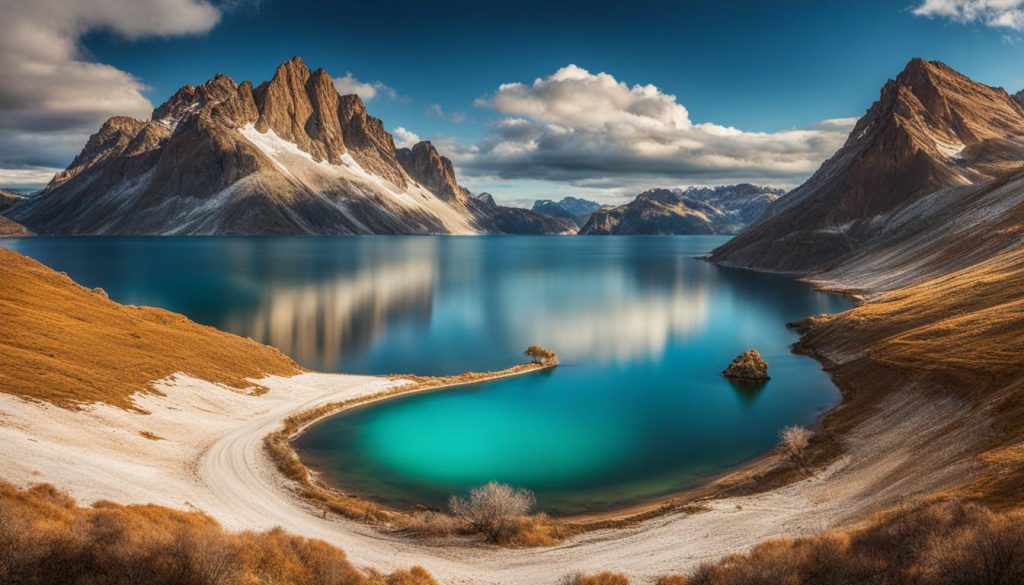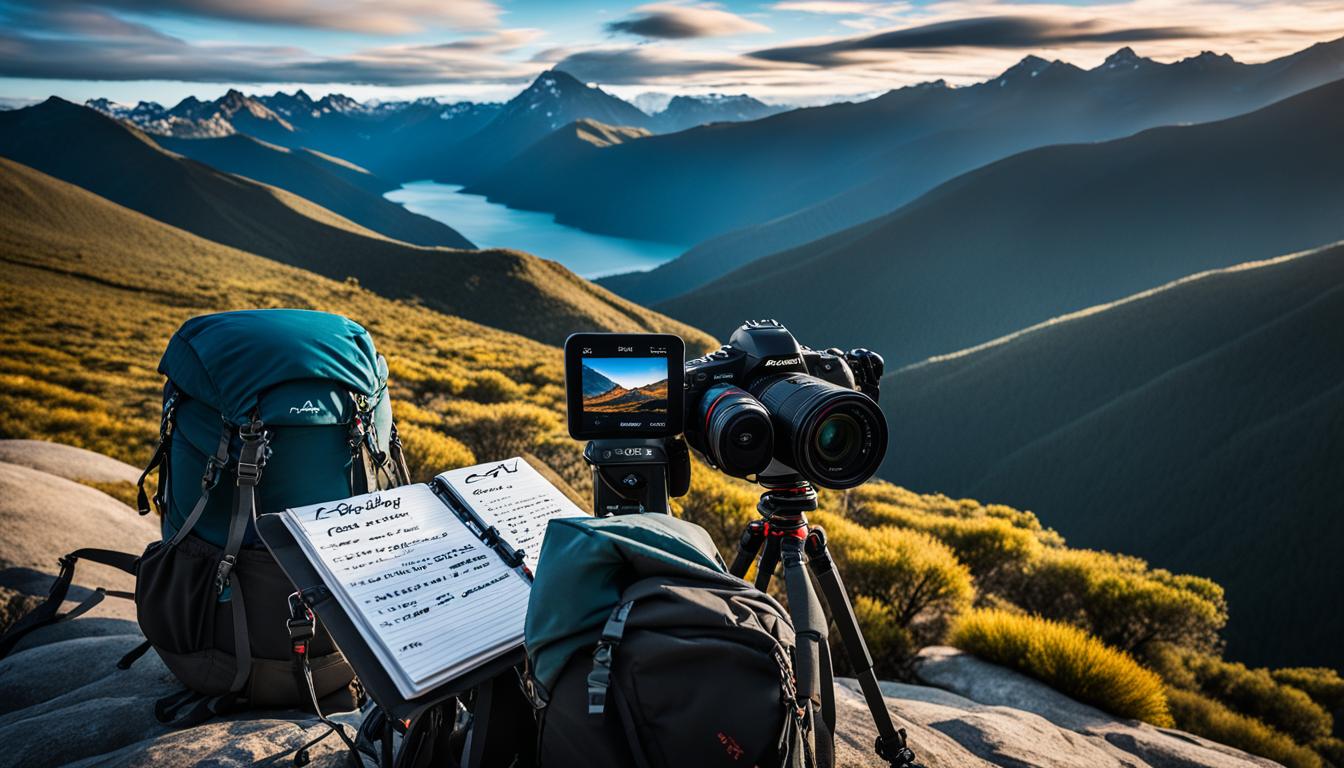If you are a landscape photographer, you know the importance of being prepared before heading out to capture nature’s beauty. A comprehensive Landscape Photography Checklist can help ensure that you have everything you need and help you avoid overlooking important items.
Having a checklist will help you stay organized and save you from the frustration of realizing you forgot something essential while out in the field. Let’s dive into the essential items you should have on your Landscape Photography Checklist to capture awe-inspiring shots of nature.
Key Takeaways:
- A Landscape Photography Checklist can help ensure that you have all the necessary equipment before heading out into the field.
- A comprehensive Landscape Photography Checklist helps you stay organized and avoid forgetting important items.
- Being prepared with a Landscape Photography Checklist saves time and avoids frustration while shooting in the field.
- Following a Landscape Photography Checklist allows you to focus on capturing breathtaking shots of nature rather than worrying about equipment or supplies.
- Creating a Landscape Photography Checklist is easy and can be customized to fit your specific needs and preferences.
Essential Camera Equipment
When it comes to landscape photography, having the right camera equipment is vital for capturing stunning shots. Here are some essential items to consider:
Camera Body
The camera body is the heart of your equipment. Choose a model that suits your needs and budget, with a high-resolution sensor and good low-light performance.
Lenses
Investing in a range of lenses can help you achieve different effects in your landscape photos. A wide-angle lens for capturing vast scenes, a telephoto lens for detailed shots far away, and a standard lens for everyday use are all great options.
Tripod
Using a tripod is essential for landscape photography to keep your shots steady and reduce camera shake. Choose a sturdy model that is light enough to carry on hikes.
Filters
Filters can help enhance your landscape photos by reducing glare, balancing exposure, and adding drama to skies and waterfalls. Polarizers and neutral density filters are great options for landscape photography.
Other Accessories
Other useful accessories to consider include extra batteries and memory cards, a camera bag for transporting your gear, a remote trigger for long exposures, and a lens cleaning kit to keep your lenses spotless.
Planning and Research
Successful landscape photography requires careful planning and research beforehand. Photographers should aim to scout out locations ahead of time and carefully study weather conditions to ensure they capture the perfect shot.
One of the most important aspects of planning is timing. Knowing the best time to visit a location and capturing it in the ideal light can make all the difference. Time of day, season, and weather conditions can all affect the final outcome of a photograph.
Researching the location ahead of time can also help photographers prepare for their shoot. This can include researching nearby landmarks, studying the terrain of the area, and discovering any natural features that may add interest to the photograph.
One useful tool for research is the use of mobile apps that provide weather forecasts and sun and moon tracking. Understanding the movement of the sun and moon can help photographers plan the perfect time to capture stunning landscapes.
Overall, planning and research are essential components of landscape photography. By taking the time to scout locations, understand weather patterns, and plan the perfect time to shoot, photographers can maximize their chances of capturing breathtaking images that truly capture the beauty of the natural world.
Composition Techniques
To capture breathtaking landscape photographs, it’s crucial to understand composition techniques. These principles help to create visually appealing images that draw the viewer’s eye. One fundamental principle is the rule of thirds, which involves dividing the image into thirds both horizontally and vertically and placing the subject or points of interest along these lines or intersections.
Another essential technique is the use of leading lines, which are visual elements in the scene that draw the viewer’s eye towards the subject. These lines can be natural, like the shape of a river or a row of trees, or man-made, such as roads or buildings.
Foreground interest is also important in landscape photography. Including a subject or object in the foreground can add depth to the image and make it more dynamic. Balancing elements within the frame is another composition technique that helps to create a harmonious and visually pleasing image. This can be achieved by including objects of similar size, color, texture, or shape in different areas of the frame.
Remember, composition techniques should not be regarded as strict rules, but rather as guidelines that encourage experimentation and creativity with your landscape photography.
Exposure and Lighting
Proper exposure and effective use of lighting are essential for capturing stunning landscape photographs. To achieve the right exposure, it’s important to understand metering and bracketing. Metering measures the light reflected from the scene, and bracketing involves taking multiple shots of the same scene with different exposures to ensure that the perfect exposure is captured.
The golden hour, which occurs during early morning or late afternoon, is a great time to capture stunning landscapes with warm, soft light. Additionally, you can make the most of natural lighting conditions by using shadows to create depth and contrast in your photographs.
It’s also essential to consider the use of filters when it comes to lighting. Graduated neutral density filters can help balance exposure levels between the sky and foreground, while polarizing filters can reduce reflections and enhance colors.
“The right use of exposure and lighting can transform an ordinary landscape photograph into a stunning masterpiece.” – Ansel Adams
Focusing and Depth of Field
When it comes to landscape photography, focusing correctly and managing depth of field are crucial for capturing stunning shots. One technique to ensure that everything in your frame is in focus is to use hyperfocal distance. This involves focusing on a specific distance that maximizes the depth of field, ensuring the foreground and background are sharp. Additionally, focus stacking involves taking multiple shots at different focus points and blending them together to create a sharp and detailed final image.
Controlling the aperture settings can also help manage depth of field. Using a wider aperture (lower f-stop) will result in a shallower depth of field, while a narrower aperture (higher f-stop) will increase the depth of field. Experimenting with different aperture settings will enable you to create different effects and draw the viewer’s attention to specific elements in your composition.
Remember, focusing and depth of field play a critical role in determining the overall look and feel of your landscape photographs. By mastering these techniques, you can create images that capture nature’s beauty in all its glory.
Compositional Filters
Compositional filters can drastically improve the quality of landscape photographs. Polarizers and neutral density filters are two examples of such filters that can enhance images. Polarizers can help reduce reflections from non-metallic surfaces, improve saturation, and improve color contrast in the sky and water. Meanwhile, neutral density filters are useful for creating long exposure effects in bright conditions, like smoothening flowing water or capturing streaking clouds.
It’s important to use compositional filters correctly to avoid over-saturating an image or going overboard with color tones. Using these filters can be complicated, so photographers should study their manuals or watch tutorial videos before using them.

Conclusion
Following a comprehensive landscape photography checklist is essential for capturing stunning shots. By having all the necessary equipment, scouting locations, researching weather conditions, understanding composition techniques, managing exposure and lighting, focusing correctly, and using compositional filters, photographers can capture nature’s beauty perfectly every time.
Remember, planning and preparation are crucial to achieving success in landscape photography. Taking the time to organize your gear, scout locations, and research weather conditions can make all the difference in capturing breathtaking shots.
So, whether you’re a seasoned pro or just starting, make sure to use this essential landscape photography checklist for your next shoot. By doing so, you’ll ensure that you’re prepared, organized, and ready to capture the perfect shot every time.






